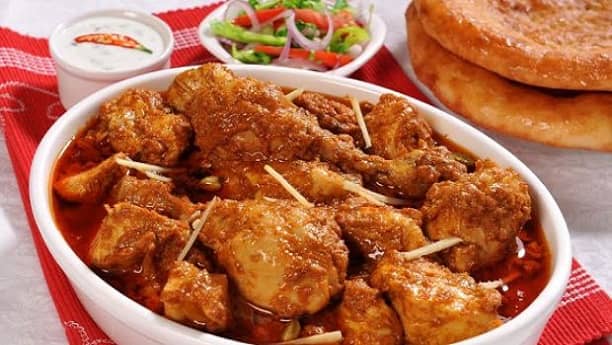Here’s a recipe for Chicken Korma:
Ingredients:
- 1 kg chicken, cut into pieces
- 2 onions, finely chopped
- 3-4 cloves garlic, minced
- 1-inch piece of ginger, minced
- 2 tomatoes, finely chopped
- 1/2 cup plain yogurt
- 1/4 cup cashew nuts
- 1/4 cup almonds
- 2 tablespoons vegetable oil or ghee (clarified butter)
- 2 bay leaves
- 4-5 green cardamom pods
- 4-5 cloves
- 1-inch cinnamon stick
- 1 teaspoon ground coriander
- 1 teaspoon ground cumin
- 1/2 teaspoon turmeric powder
- 1/2 teaspoon chili powder (adjust to taste)
- Salt to taste
- Fresh coriander leaves for garnish
Instructions:
- In a blender, combine the cashew nuts, almonds, and yogurt. Blend until you get a smooth paste. Set aside.
- Heat the vegetable oil or ghee in a large pan over medium heat. Add the bay leaves, cardamom pods, cloves, and cinnamon stick. Sauté for a minute until fragrant.
- Add the chopped onions to the pan and cook until they turn golden brown.
- Stir in the minced garlic and ginger, and cook for another couple of minutes until fragrant.
- Add the chopped tomatoes to the pan and cook until they soften and the oil starts to separate.
- Now, add the chicken pieces to the pan and cook until they are lightly browned on all sides.
- Add the ground coriander, cumin, turmeric, chili powder, and salt to the pan. Mix well to coat the chicken evenly with the spices.
- Pour in the yogurt and nut paste mixture into the pan. Stir everything together until the chicken is well coated with the sauce.
- Cover the pan and let the chicken simmer over low heat for about 20-25 minutes, or until it is cooked through and tender. Stir occasionally to prevent sticking.
- Once the chicken is cooked, remove the lid and cook for an additional 5-10 minutes to thicken the sauce to your desired consistency.
- Garnish with fresh coriander leaves before serving.
- Serve hot with rice, naan, or roti.
Enjoy your homemade Chicken Korma!
FAQs
-
What is Chicken Korma sauce made from?
- Chicken Korma sauce typically consists of a blend of yogurt, nuts (such as cashews and almonds), and aromatic spices like cardamom, cloves, cinnamon, coriander, and cumin. These ingredients are combined to create a rich and creamy sauce that coats the chicken pieces, imparting a luxurious flavor and texture to the dish.
-
What is the difference between chicken curry and korma?
- The main difference between chicken curry and chicken korma lies in their flavor profiles and ingredients. Chicken curry often features a tomato-based sauce with a combination of spices like cumin, coriander, turmeric, and chili powder. It tends to have a spicier and tangier taste. On the other hand, Chicken Korma is known for its creamy texture derived from the use of yogurt and nuts. It typically has a milder, sweeter flavor profile due to the addition of ingredients like almonds, cashews, and sometimes coconut milk. Korma also tends to incorporate more aromatic spices like cardamom, cloves, and cinnamon.
-
Is Chicken Korma like Butter Chicken?
- While both Chicken Korma and Butter Chicken are creamy and indulgent Indian dishes, they have distinct differences in flavor and preparation. Chicken Korma features a creamy sauce made with yogurt and nuts, seasoned with aromatic spices. Butter Chicken, on the other hand, is characterized by a rich and buttery tomato-based sauce, often enriched with cream or butter. Additionally, Butter Chicken typically includes the distinctive flavor of fenugreek leaves (kasuri methi), giving it a unique taste. While both dishes offer a luxurious dining experience, they each have their own distinct flavor profiles.
-
What is korma masala made of?
- Korma masala is a blend of spices used to season Chicken Korma and other korma dishes. The exact ingredients can vary, but typical components include ground coriander, cumin, cardamom, cloves, cinnamon, nutmeg, and sometimes black pepper. These spices are often combined with other ingredients like ginger, garlic, and onion to create a flavorful masala paste or powder that forms the base of the korma sauce. Additionally, some recipes may include ingredients like poppy seeds, fennel seeds, or dried fenugreek leaves to enhance the complexity of the flavor.

Pages: 1 2
